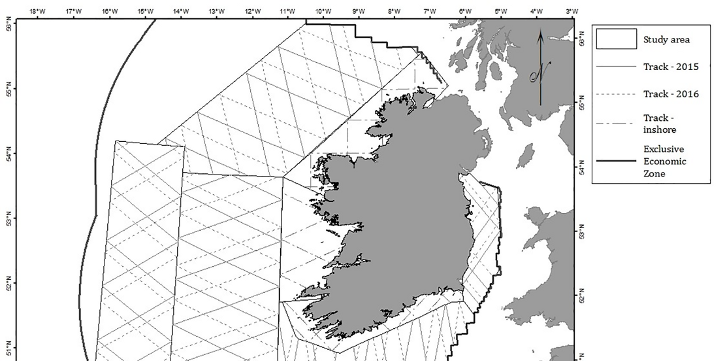In This Section
Ground Breaking Research into Ireland's Offshore Habitats and Species

The ObSERVE team announce the findings of three-year projects to study large areas of the Atlantic Margin, Celtic and Irish seas.
The Minister for State, Community Development, Natural Resources and Digital Development, Mr. Sean Canney T.D.recently welcomed publication of the findings from the ObSERVE Programme, a government funded initiative, to enhance our knowledge and understanding of protected species and sensitive habitats offshore Ireland through high quality data collection.
The ObSERVE Programme is being delivered by the Department of Communications, Climate Action & Environment, in partnership with the National Parks and Wildlife Service of the Department of Culture, Heritage and the Gaeltacht. €2.7m has been invested by government in the programme to date.
Recently, the ObSERVE team announced the findings of the twin ObSERVE Aerial and ObSERVE Acoustic projects, led by University College Cork and Galway Mayo Institute of Technology respectively, both of which began in the spring of 2015 and spanned three years of data collection and analysis. The projects surveyed large areas of the Atlantic Margin, Celtic and Irish seas.
Key Findings
Whales:
- Twenty species of cetacean (i.e., whales, dolphins & porpoises) were recorded, analysed and mapped with almost 2,200 sighting records over the two-year field study.
- Cumulative abundance of 380 Sperm whales was found using acoustic detection and tracking methods.
- Species such as the Beluga/White whale were found - a mainly Arctic species
- Minke whales were the most frequently observed and abundant baleen whale species, numbering approximately 12,000 in summer and 5,000 in winter and there were significant sightings of Minke whale calves
- Fin whales occurred in Irish waters both in summer and winter, the analysis showing the continental slope and nearby deep waters to be an important area for this species, possibly for feeding and/or migration.
- Many sound recordings were made of rarely-seen beaked whales, which are deep-diving offshore species poorly known to science.
- At least three species of beaked whales were recorded during the ObSERVE surveys, primarily in deep oceanic waters along the continental margin, the Porcupine and eastern Rockall Basins. The records collected during the aerial project were sufficient to provide the first estimates recorded for this study area of 2,500 individuals in summer and 4,000 in winter.
- Endangered Blue whales could be detected underwater up to 115-200km away and strong seasonal patterns in their sounds were noted and described.
Dolphins:
- Considerable variation was found in the distribution, abundance and movements of dolphin species
- Bottlenose dolphins were much more abundant during the winter than the summer, with densities in the second winter (2016-17) being among the highest ever recorded.
Overall the ObSERVE Programme highlights the importance of Ireland’s Atlantic Margin for many whale and dolphin species.
Seabirds:
- Aerial surveys highlight the importance of the Atlantic Margin for seabirds with almost half a million seabirds located within the study area during both summer and winter, with bird densities highest in coastal areas. 10,000 sightings of seabirds were recorded, representing 24 species.
- The Western Irish Sea is shown to be of major importance for seabirds. 6,687 km of fine-scale aerial surveys were carried out in this area in 2016[1]. They estimated 100,000 birds present in summer, 90,000 in winter, with migrating seabirds boosting these estimates to 300,000 in the autumn.
- White-tailed Tropicbirds were found during ObSERVE Aerial, a species usually seen in the tropics.
Beluga whale sighted during three year survey of cetaceans off the west coast of Ireland! @uccBEES @ObSERVE-Acoustic @GMIT @NPWS https://t.co/dmqCDtokCC
— ORCireland Observers (@ORCireland) November 23, 2018
Welcoming the findings, Minister for State, Community Development, Natural Resources and Digital Development, Sean Canney T.D., said:
“The ObSERVE programme, shows how important it is that government keeps investing in research into our marine environment. The information gathered by the ObSERVE Programme has significantly improved our knowledge of the environment, offshore Ireland, and will help to point the way forward for future regulation and sustainable development in tandem with advancing the conservation of protected species”.
Dr Mark Jessopp of the School of BEES, UCC (ObSERVE Aerial) commented: “The ObSERVE aerial programme was particularly ambitious and logistically challenging, but has provided essential information on the distribution of cetaceans in summer and winter over two consecutive years. In addition, it has provided essential information on seabirds during both the summer breeding and overwintering periods. This is the first time we have been able to get robust estimates of cetacean abundance in winter and seabird abundance at sea essential to inform management and conservation of populations”.
The ObSERVE Programme is contributing vital information on the occurrence, distribution and density of sensitive species within key offshore areas. This and future information generated under the programme will provide robust environmental baseline data and confidence to the regulatory regime in assessing offshore activities including oil & gas exploration, cables and offshore wind, and to conservation authorities responsible for the protection of marine biodiversity.
ObSERVE Programme reports and datasets are being made available to all interested parties through the Department of Communications, Climate Action and Environment’s website and, in addition, through the National Biodiversity Data Centre which provides an online platform for mapping Ireland’s biodiversity.
Endangered blue whales, beluga whales usually found in the Arctic and Caribbean tropicbirds were found in Irish waters by scientists working on the largest study of Irish marine life ever conducted https://t.co/xToQ3Qra90
— The Times IE (@thetimesIE) November 23, 2018
School of Biological, Earth and Environmental Sciences
An Scoil Eolaíochtaí Bitheolaíocha, Domhaneolaíocha agus Comhshaoil
Contact us
Distillery Fields, North Mall, University College Cork, Ireland , T23 TK30
